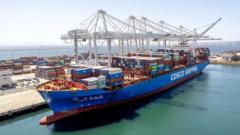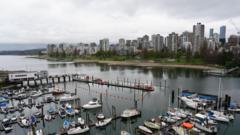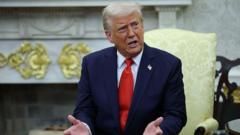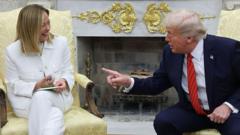Taiwanese exporters face challenges as tariffs disrupt their business models, leading to increased uncertainty and competition from Chinese manufacturers.**
Uncertainty Looms for Taiwanese Exporters Amid Tariff Challenges**

Uncertainty Looms for Taiwanese Exporters Amid Tariff Challenges**
Small factories in Taiwan grapple with the impact of tariffs and market unpredictability as they adapt to a changing global trade landscape.**
Despite a temporary tariff reprieve from the U.S., Taiwan's small factories, like Aegis CNC, find themselves confronting a turbulent global trade environment. Alex Tang, who operates the lathe-making company in Taichung, has rallied his team amidst the anxiety brought on by President Trump's ever-changing tariff policies. The initial pause has offered a sense of relief, but lingering threats of a 10 percent tariff loom over Taiwanese products, significantly impacting exporters.
With China's export levels facing hefty tariffs, it could create a competitive shift, introducing further challenges for Taiwanese manufacturers. Tang, leveraging his business agility, emphasizes the interconnected nature of trade, indicating that uncertainty affects not only those exporting directly to the U.S. but ripples through the entire supply chain.
During recent discussions, Tang noted that U.S. buyers, caught in a predicament of what the future holds, have halted orders, exacerbating the anxiety surrounding the market. The pressures of both tariffs and unpredictability have compelled Taiwanese exporters to adopt a more strategic, flexible approach to business. Amid these discussions, Taiwan's President, Lai Ching-te, engaged with the local manufacturing community to assess their concerns and strategize on overcoming these hurdles.
As Taiwan navigates these turbulent waters, the resilience and adaptability of its export-dependent economy will be put to the test as they contend with not just the looming tariff threat but also shifting dynamics within the global marketplace.
With China's export levels facing hefty tariffs, it could create a competitive shift, introducing further challenges for Taiwanese manufacturers. Tang, leveraging his business agility, emphasizes the interconnected nature of trade, indicating that uncertainty affects not only those exporting directly to the U.S. but ripples through the entire supply chain.
During recent discussions, Tang noted that U.S. buyers, caught in a predicament of what the future holds, have halted orders, exacerbating the anxiety surrounding the market. The pressures of both tariffs and unpredictability have compelled Taiwanese exporters to adopt a more strategic, flexible approach to business. Amid these discussions, Taiwan's President, Lai Ching-te, engaged with the local manufacturing community to assess their concerns and strategize on overcoming these hurdles.
As Taiwan navigates these turbulent waters, the resilience and adaptability of its export-dependent economy will be put to the test as they contend with not just the looming tariff threat but also shifting dynamics within the global marketplace.






















